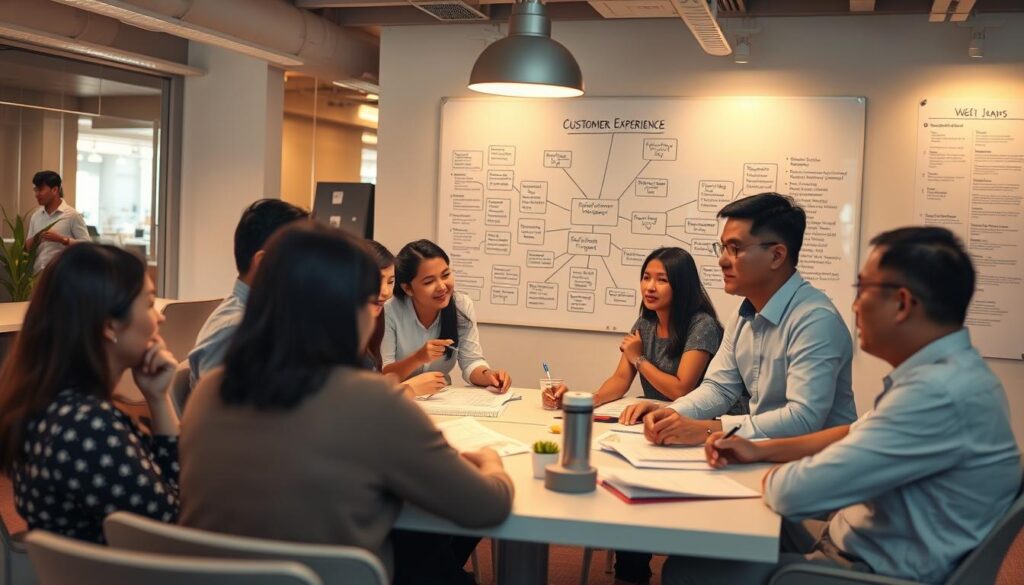What if the obstacles blocking better customer satisfaction are also chances for growth? Businesses aiming to boost customer experience face many challenges. In Southeast Asia, like the Philippines, changing how companies think and work together is key.
By tackling these hurdles, companies can make their customers happier and keep them coming back. This helps protect their good name in the market.
Key Takeaways
- Understanding the obstacles in customer journey is vital for effective optimization.
- Overcoming these barriers can lead to enhanced customer satisfaction and loyalty.
- Corporate collaboration is essential to tackling customer experience challenges.
- Recent insights from the Philippines highlight the need for mindset shifts within companies.
- Failing to address these issues can adversely affect brand reputation and customer retention.
Understanding the Customer Journey: A Framework for Optimization
Mapping the customer journey helps businesses improve at every step. Each interaction, from first contact to after-sales support, gives valuable insights. This lets companies see what works well and what needs work.
Getting feedback from customers is key. By watching data closely, businesses can change their plans to fit what customers want. This way, companies can understand their audience better, offer custom solutions, and keep customers happy.
By using different metrics and listening to users, companies can make big changes. Happy customers help a business grow, creating a strong partnership that benefits everyone.
| Customer Journey Stage | Key Activities | Opportunities for Improvement |
|---|---|---|
| Awareness | Advertising, Social Media, Word of Mouth | Enhance targeting through data analysis |
| Consideration | Product Reviews, Comparisons, Webinars | Streamline information for better clarity |
| Purchase | Checkout Process, Payment Options | Improve ease of checkout to reduce cart abandonment |
| Post-Purchase | Follow-Up Emails, Customer Service | Solicit feedback to identify potential issues |
These steps lay the groundwork for constant improvement in user experience. Each stage offers a chance for businesses to meet customer needs better.
Common Obstacles in Customer Journey Assessment
Understanding and tackling customer journey challenges is key for businesses wanting to improve their customer service. A big problem is when departments work alone, creating barriers to teamwork. This makes it hard to work together to better serve customers.
Marketers often face too much data, which makes it hard to make decisions. This can slow down finding important customer touchpoints and service issues. Also, not knowing how departments can work together adds to the hurdles in customer journey assessments.

To beat these challenges, companies need to build a team culture. Encouraging everyone to talk openly and share goals helps create better strategies for meeting customer needs. By tackling these common hurdles, businesses can improve customer satisfaction and grow.
Collaborative Mindset: Breaking Down Internal Silos
A collaborative mindset is key for better customer satisfaction. Good teamwork helps share information and map customer journeys well. By focusing on customers, companies can meet their needs better.
Talking across departments is a big help. It helps solve customer problems together. This teamwork drives business success.
Encouraging Interdepartmental Communication
Good communication between teams is crucial. Regular meetings and shared platforms help everyone share ideas. This way, companies can quickly respond to customer feedback.
Sharing goals related to customer experience is also important. It keeps everyone focused on what matters most.
Management’s Role in Driving Collaboration
Leaders have a big role in team collaboration. They set clear goals and KPIs to motivate teams. This way, everyone works together to improve customer satisfaction.
Incentives for teamwork make departments work as one. This approach benefits the company and makes improving the customer journey easier. Using effective collaboration tactics helps overcome customer challenges.
The Challenge of Omnichannel Marketing
In today’s fast-paced digital world, brands face a big challenge. They need to implement effective omnichannel marketing. This means combining different customer touchpoints to improve online experiences.
By linking online and offline channels, businesses can offer a unified customer journey. This makes the customer’s experience better and more consistent.
Integrating Multiple Customer Touchpoints
For omnichannel marketing success, organizations must connect various customer touchpoints. These include social media, email, websites, and physical stores. A consistent brand message is key to a great customer experience.
Customers like a smooth transition between channels. So, it’s important for businesses to manage their strategies across platforms.
Educating Distributors on Customer Behavior
Another important step is teaching distributors about customer behavior. When distributors know what their audience likes, they can connect better. This builds stronger relationships and improves the overall experience.
By giving distributors this knowledge, businesses stay ahead in the market. They can offer strategies that really speak to their target audience.
Overcoming Data Overload: Streamlining Customer Insights
Marketers today struggle with too much data, making it hard to get useful insights. To tackle this, companies need to find the most important data points. These points show how customers behave and what they like. By focusing on these, businesses can make digital experiences better for users.
Identifying Key Data Metrics
Choosing the right data is key to understanding what customers want. Metrics like Customer Satisfaction (CSAT) and Net Promoter Score (NPS) are very helpful. They help businesses cut through the clutter and focus on what really matters for a better user experience.
Focusing on Customer Pain Points
It’s important to know and fix what bothers customers. By focusing on these issues, companies can make things smoother. This not only solves problems but also builds trust and loyalty, which are crucial for success.
Crafting a Customer-Centric Culture
A customer-centric culture is key to a successful business. It boosts customer satisfaction and improves the overall experience. To build this culture, empathy is crucial at every level.
This approach helps employees understand what customers need and want. It leads to stronger, more meaningful relationships.
Building Empathy Throughout the Organization
Training programs focused on the customer’s view can change how employees interact. By connecting with customers, empathy grows. This makes the team work together to give great service.
Initiatives that share real customer stories also help. When employees see how their work affects customers, they feel more driven to serve well.

Deploying the Right Technologies for Optimization
In today’s fast-paced digital world, picking the right tech is key for better user experience. Businesses need tools that analyze data and offer insights into customer behavior. This choice greatly affects how well companies improve their customer journeys.
Choosing Tools for Accurate Data Interpretation
When picking tools for data analysis, focus on features that match your business goals. Look for platforms with strong analytics, easy-to-use interfaces, and quick reports. This way, you can make smart choices that lead to better insights and a better user experience.
Utilizing Experience Optimization Platforms
Experience optimization platforms change how businesses connect with their customers. For example, Contentsquare offers deep analytics on how users interact with websites. By using these platforms, companies get valuable insights to fix issues and improve user experience. These technologies are key in making strategies that meet customer needs.
| Platform Name | Key Features | Benefits |
|---|---|---|
| Contentsquare | User behavior analytics, heatmaps, session replay | Improves engagement, identifies pain points, increases conversions |
| Google Analytics | Traffic analysis, demographics, conversion tracking | Offers comprehensive insights, enhances strategic decisions, free for basic use |
| Hotjar | Heatmaps, visitor recordings, feedback polls | Visualizes customer interactions, gathers user feedback, easy to implement |
Identifying and Prioritizing Customer Experience Problems
Understanding customer experience problems is key for business growth. Each customer’s journey has unique challenges. Ignoring these can block big improvements in how users feel about a product or service.
Businesses can use surveys and tests to find out where things go wrong. This helps them see what needs fixing. It’s important to focus on the biggest issues first.
By breaking down customer journeys into parts, companies can tackle problems more easily. This way, they can make a bigger impact with their efforts.
Looking at data is crucial. It shows which parts of the experience need work. With this knowledge, businesses can make changes that improve how users feel and keep them coming back.

Obstacles in Customer Journey: Optimizing Customer Experience
Fixing obstacles in the customer journey needs a smart plan. Businesses should create a detailed CX strategy. This strategy should look at every point where customers interact with the company.
It’s important to know what customers like and don’t like. This can be done by listening to their feedback often. By using different ways to get feedback, companies can find out where they need to improve.
Implementing a Comprehensive CX Strategy
A good CX strategy puts customers first. It uses customer insights to make better choices. This way, companies can make their customers happier and more satisfied.
It’s key to keep checking and updating this strategy. This ensures it stays relevant as customer needs change.
Tracking Customer Feedback Across Channels
Getting feedback from customers is crucial. It helps understand what they think and feel. Using tools that collect feedback from various places gives a complete picture of the customer experience.
By studying this feedback, companies can make smart changes. This helps them stay ahead and keep improving the customer experience.
The Importance of Continuous Experimentation
To stay ahead in today’s fast-changing market, businesses must keep experimenting. This helps them adjust and improve their strategies. It also focuses on making the customer experience better. By constantly trying new things, companies can find out what their customers like best.
Learning from Customer Interactions
Every time a customer interacts with a brand, it’s a chance to learn. By listening to feedback, watching how customers behave, and analyzing data, companies can gain valuable insights. Using these insights, brands can create experiences that are more personalized and meet customer needs better.
Adjusting Strategies Based on Insights
Using the insights from customer interactions is key to success. Brands that make changes based on what they learn can better meet customer needs. This ongoing process helps businesses stay in tune with their audience and improve customer satisfaction.

Conclusion
Navigating the obstacles in customer journey optimization is key for businesses wanting to boost customer satisfaction. A collaborative mindset among teams is essential. It leads to open communication and smooths out issues.
This approach encourages innovative solutions and helps spot areas for improvement in the customer experience. Using the right technologies is also crucial. It streamlines processes and gives valuable insights.
By using these tools and learning from customer feedback, organizations can tackle major challenges. This effort not only brings immediate business gains but also builds lasting customer relationships. This is important in a diverse market like the Philippines.
By focusing on strategies that empower teams, businesses can succeed in a competitive world. This ongoing commitment to improving the customer experience creates a culture that values every interaction.

